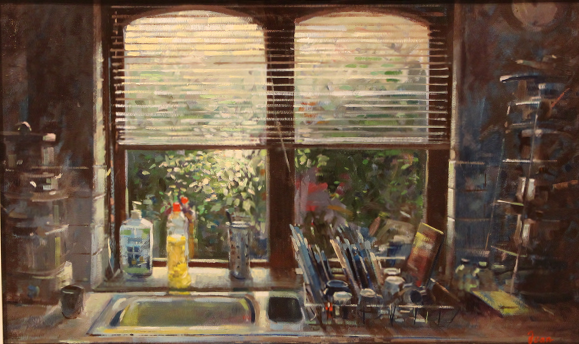
Everything and the Kitchen Sink, Bill Dean ROI WGA, Oil
As seen at the Mall Galleries Royal Institute of Oil Painters last December. Looking back, some amazing works shown.
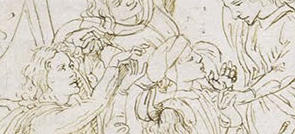

At the mid-point of the path through life, I found
Myself lost in a wood so dark, the way
Ahead was blotted out.
The Courtauld are showing Botticelli's drawings of Dante's Divine Comedy, and they're very good.
These drawings were part of a whole collection sold by the 12th Duke of Hamilton to the Berlin Kupferstichkabinet museum in 1882 to cover his gambling debts: a real loss many people tried to prevent at the time.
Showing thirty illustrations, drawn in silverpoint, pen and ink between 1480-1495, they are beautifully detailed and realised pieces. The number of figures drawn and the detail is remarkable: more remarkable if you pick up one of the free magnifying glasses available, which I thoroughly recommend.
Not just hell, but purgatory and paradise are present, with Botticelli seemingly having a lot of fun drawing some of the grotesque devils and torments in Dante's classic. Amazing work.
Botticelli and Treasures from the Hamilton Collection is on at The Courtauld Gallery until May 15th 2016.

-small.jpg)

I was very sorry to read about the death of the great Italian author Umberto Eco on Friday. I was only looking at his new novel Numero Zero the other day and adding it to my list of books I want to read. I loved The Name of the Rose, and every year I tell myself that I need to re-read Foucault’s Pendulum, something I read a long time ago and found both hugely enjoyable and mysterious. It is so rare that an intellectual Italian like Eco can cross-over into the mainstream Anglophone book world (let alone mainstream Italian book world). His death is a big loss.

I've been wanting to do this post for quite a while, but it's been one of those that has proved harder to write, wanting to do it justice.
The concept of "who, where and what" with the "Celts" can get both muddy and contentious today because it's mixed up with very modern notions of nation and nationalism, something the Iron Age tribes themselves pre-date of course. The British Museum and the National Museum of Scotland do a good job however, and try to put some context to the archaeology.
The exhibition Celts: Art and Identity has now left the British Museum and is off to Edinburgh's National Museum of Scotland. If you're in Edinburgh or environs, you should definitely have a look (it starts March 10th).
There was a lot to like, particularly the first half dealing with the ancient origins and archaeology. Some of the exhibits are familiar, such as the "Great Torc" from the Snettisham Hoard, something I've written about before.
Perhaps my favourite items on display are the Gundestrup Cauldron and the Braganza Brooch.
Gundestrup Cauldron
The Gundestrup Cauldron was dug out of a peat bog in Jutland, Northern Denmark, in 1891. It is the star attraction of the Danish National Museum in Copenhagen and a very sought after loan. You can see why :
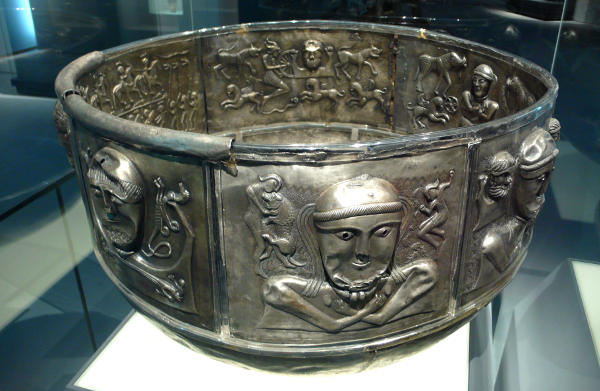
This is a very strange work in some ways, and found a long way from the usual "Celtic" areas of Europe. Although it has some Celtic elements (e.g. figures wear a torc, some are blowing the carnyx, a horn-like instrument), others are harder to explain as "Celtic". It is far from the usual swirling, organic Celtic forms.
Some parts of it seem almost shamanic, such as the antered figure hammered out of the silver on an inside panel :
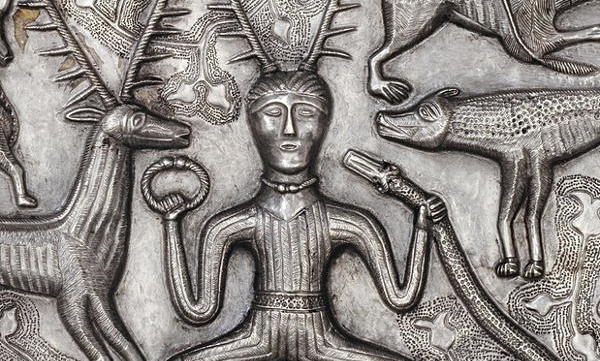
Where was the cauldron made? No one is sure, but some people posit Thrace, an ancient land now covered by much of modern Bulgaria and European Turkey.
Braganza Brooch
The Braganza Brooch is much smaller but just as beautiful. It only measures about 14 cm long, 5 cm high. Made of gold and some glass, it shows a naked warrior with a celtic style helmet, a sword and a dog (or dragon?) jumping up at him, with his shield pressed up anb blocking the beast.
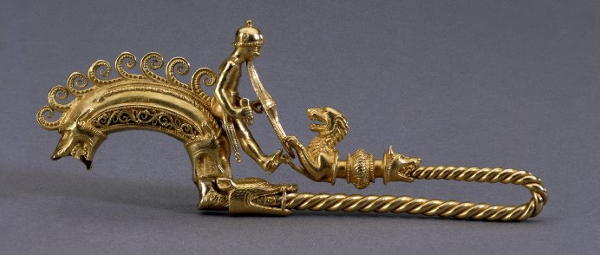
It has exquisite detail and workmanship :
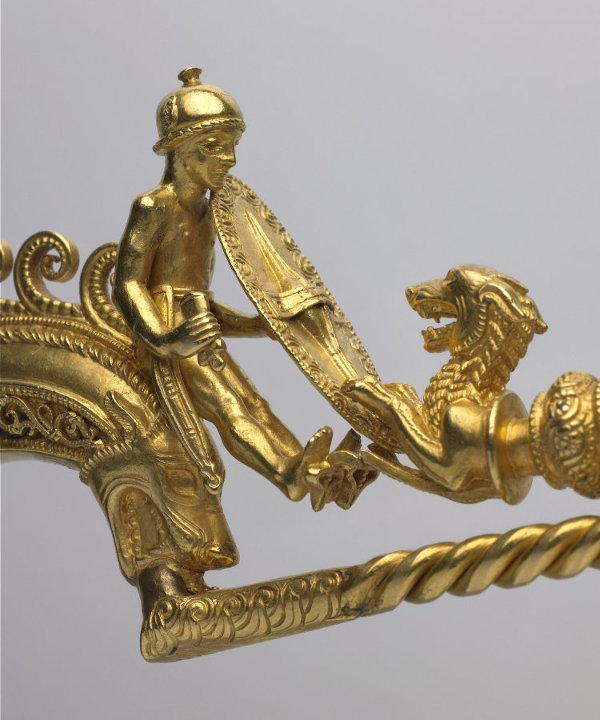
For more detail and background on the brooch, see The History of the Braganza Gold Brooch.
Overall, well worth a visit for many very interesting things in addition to cauldrons and brooches. There's a full size reproduction of a Celtic chariot, the Battersea Shield and even some Phoebe Anna Traquair, someone with some impressive artifacts in Edinburgh that I've written about before.
Nikolai Astrup has some beautiful paintings on show at Dulwich just now. Colourful and magical evocations of life in the Norwegian countryside in the early 20th century. The love he shows for his landscape, people and customs is palpable, which makes the work he produced in his short life very special.
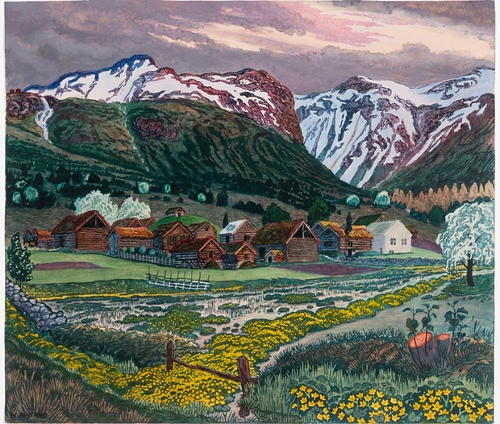
Marsh Marigold Night, c 1915
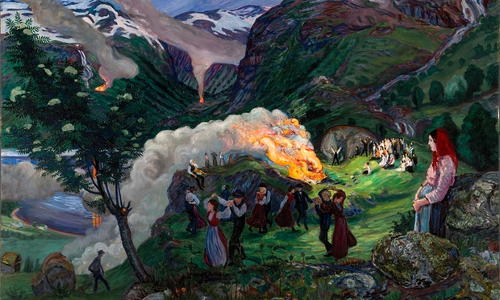
Midsummer Eve Bonfire, before 1915
Astrup hardly moved from his place of birth, living in the same village or not far away, all his life. He documented the village, the village folk, the garden and the landscape he could see from his window. He was only 48 years old when he died and an early picture of his shows a village funeral. It would have been almost exactly the same as his own twenty years or so later.
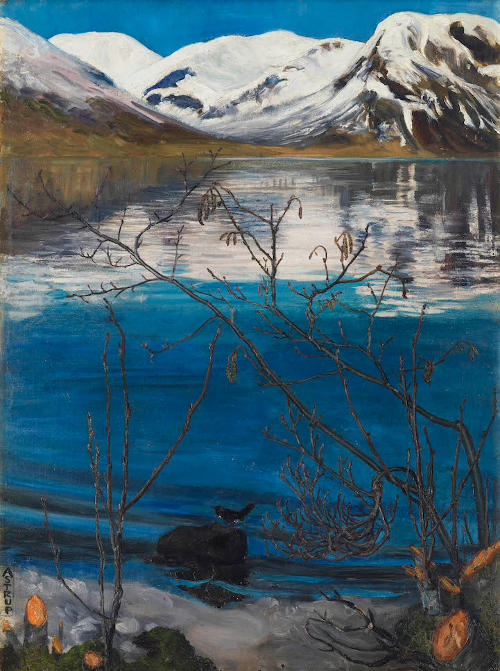
March Atmosphere at Jølstravatnet, Before 1908
You can see some more at the Dulwich Picture Gallery site. Another good web site to visit is here and The Guardian has a good write up. Better still, go to the exhibition.
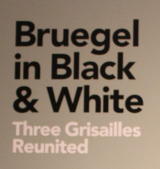
The Courtauld Gallery has a small Bruegel exhibition showing three of his very rare grisaille paintings side by side. The gallery is also displaying other Bruegel drawings in the collection, along with copies and some fakes (good drawings, but made to deceive).
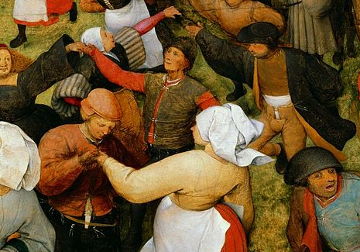
The Wedding Dance (detail), Pieter Bruegel the Elder, c. 1566
We have to be careful we know which Bruegel we are talking about because there are a few in the family, all artists. The one doing the grisaille is Pieter Bruegel the Elder, famous for his "peasant" scenes: idiosyncratic and often charming (see right). He had two sons, Pieter Brueghel the Younger and Jan Brueghel the Elder, with Peiter spending most of his artistic life copying his father, whilst Jan did a lot of still-life and landscape painting (and sometimes collaborated with Rubens, another artist well represented at The Courtauld).
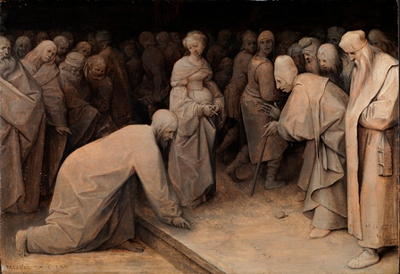
Christ and the Woman Taken in Adultery,
Pieter Bruegel the Elder, 1565
A grisaille is a black and white painting (perhaps with some umber as well) often thought to be used as a preliminary underpainting for a finished work in full colour oil. His Christ and the Woman Taken in Adultery was highly praised, and a picture he like so much that he never parted with it.
One of the things I noticed this visit was how good the Tiepolo San Pascual oil sketches are. In the early 1770's, Giovanni Battista Tiepolo was in Madrid and commissioned by King Charles III of Spain to paint some altarpieces for the church of San Pascual in Aranjuez. Apparently, the King was not impressed with the finished works and they were removed from the church and lost or destroyed (horrendous to think of the loss now). The surviving sketches are wonderful though.
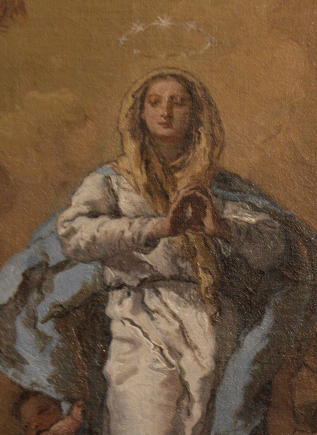
Shown below is the Immaculate Conception of 1767. Size is 60 x 40 cm (roughly), so fairly small (On the right is a close-up). The style is fluid and accomplished, quite modern and beautiful.
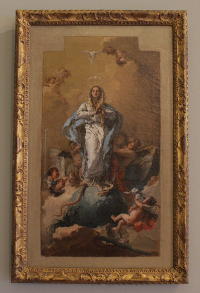
The picture on the right is a drawing by Kelvin Okafor called Jasmins Interlude. I came across this at the Mall Galleries on Saturday morning in the Columbia Threadneedle Prize Show
Visitors can vote for their favourite piece and I had 3 or 4 in mind, but I ended up casting my vote for this. It really stopped me in my tracks when I first saw it. Extremely realistic and drawn with a supreme level of drawing skill. Quite amazing.Okafor is a British artist (of Nigerian descent) with a website and blog. You can see him at work in a long sequence of photographs there. Very meticulous and fine work.
Right: Kelvin Okafor, Jasmins Interlude, Graphite and charcoal, 74 x 55 cm




